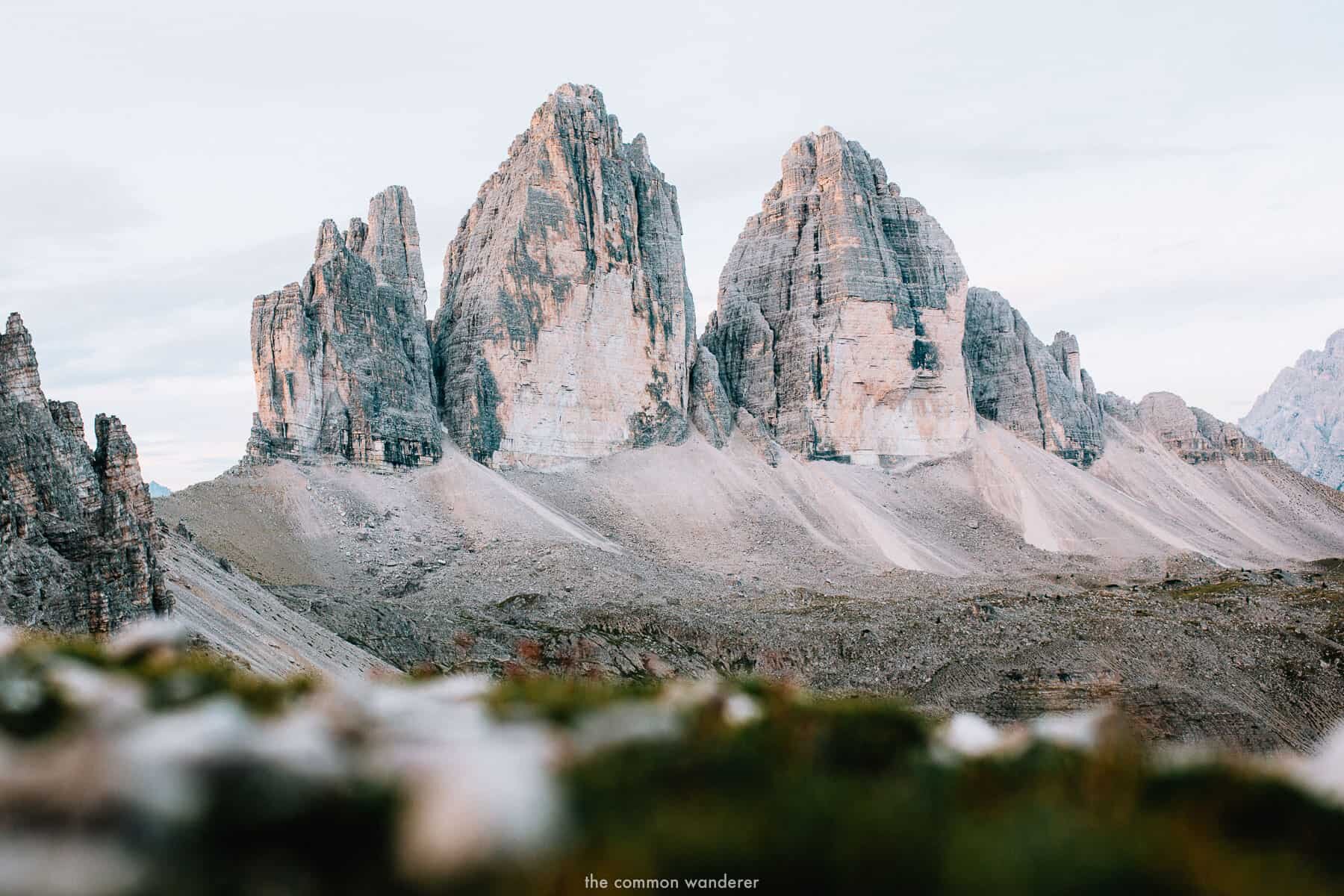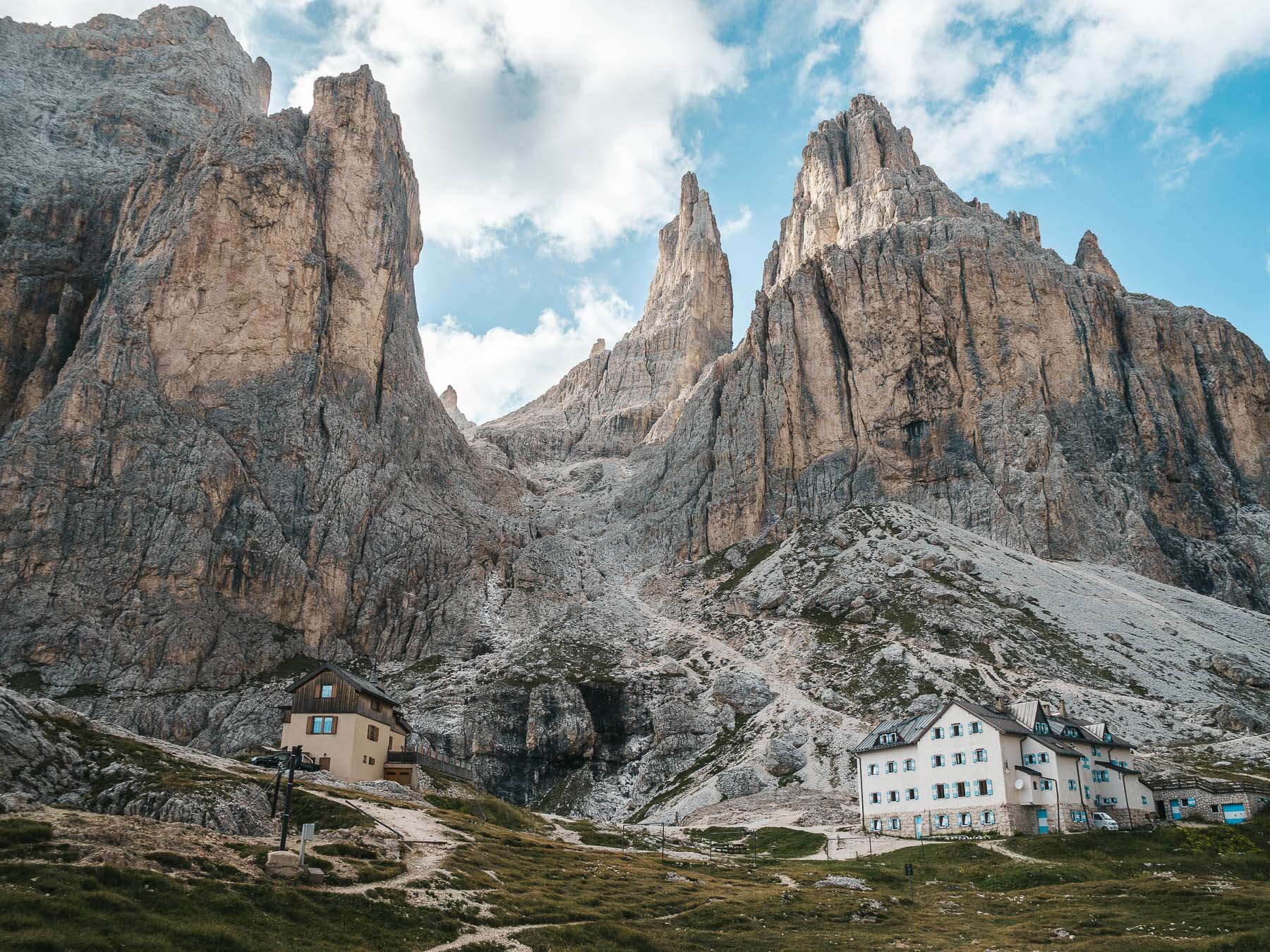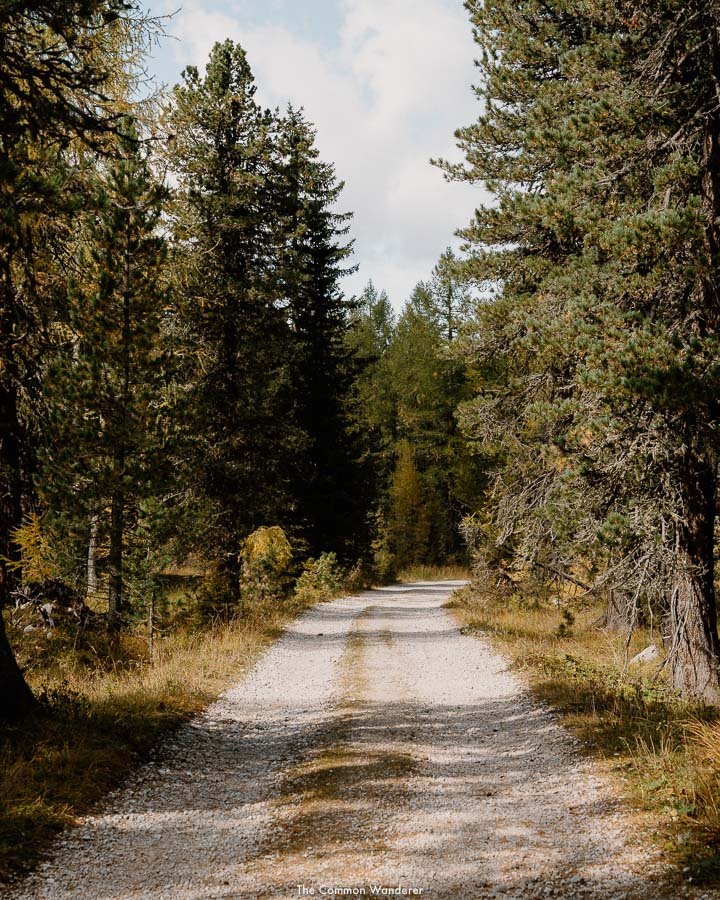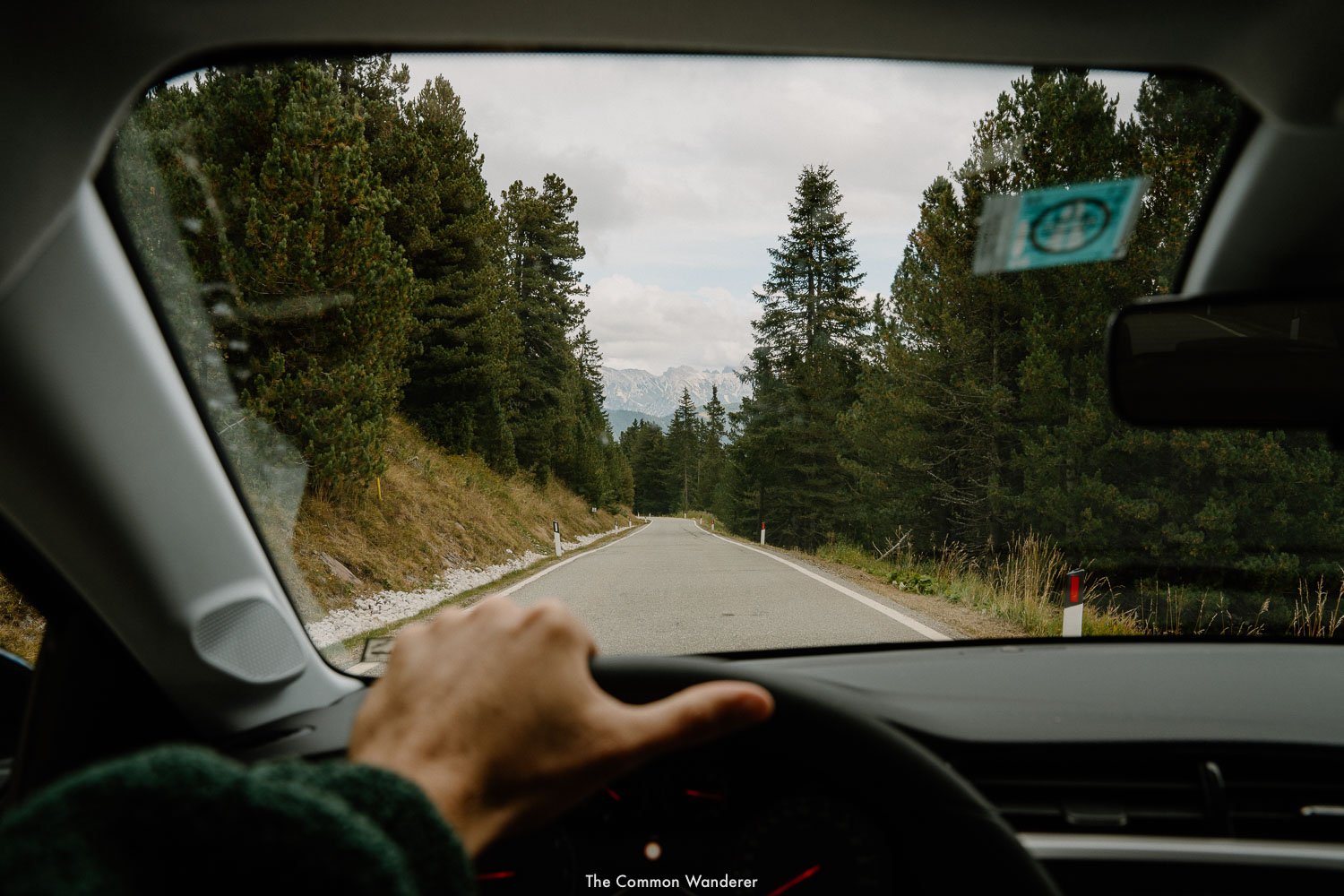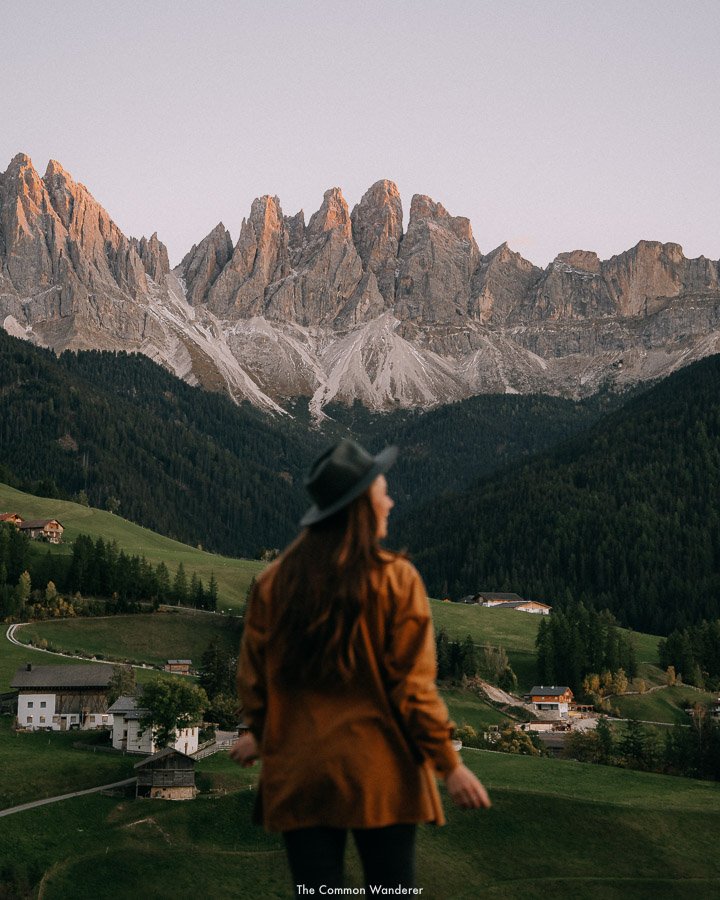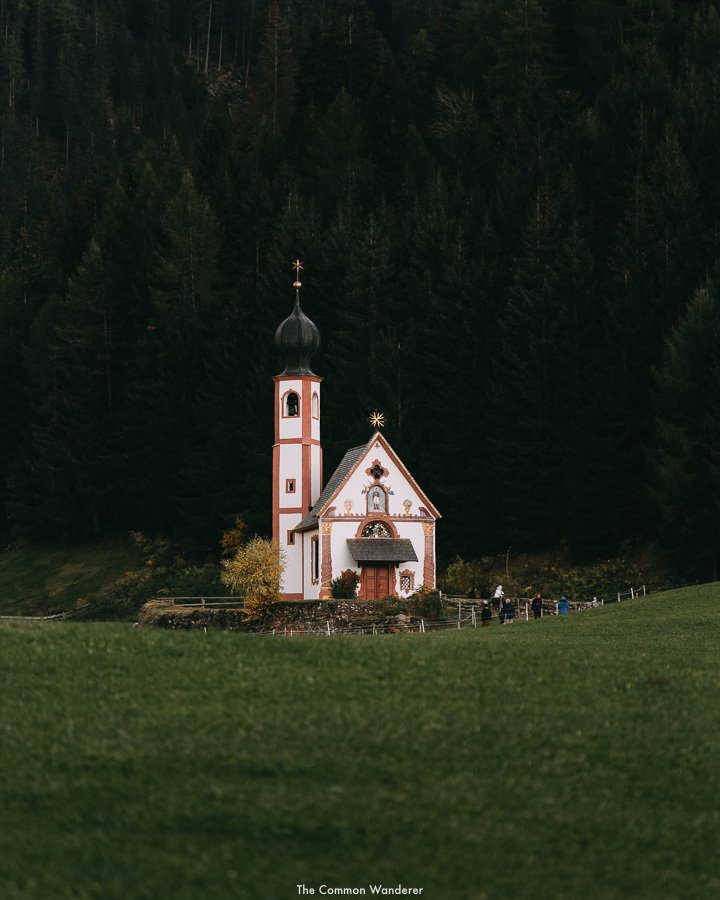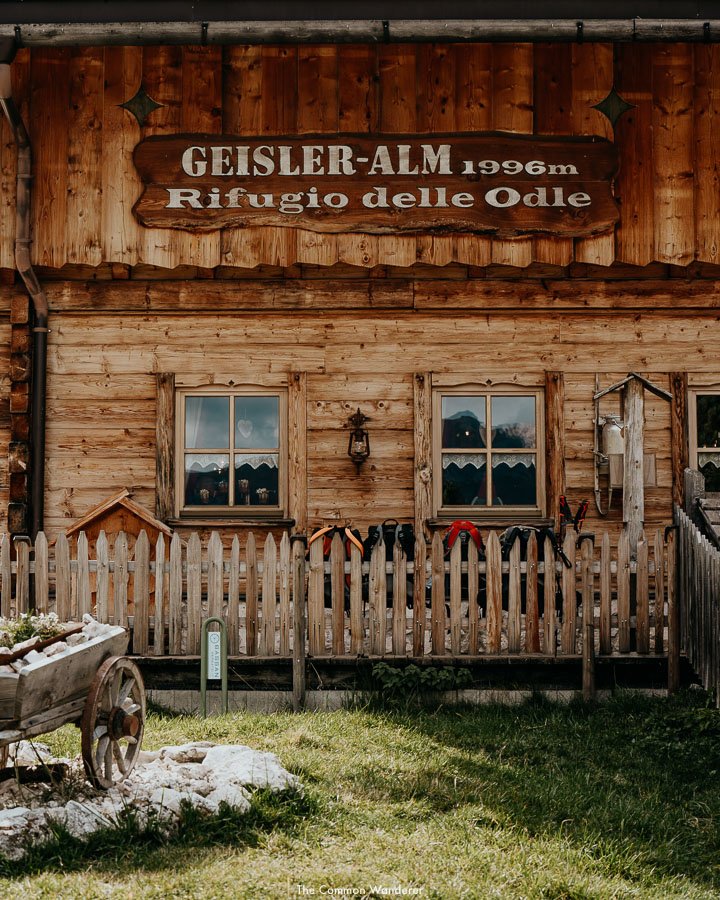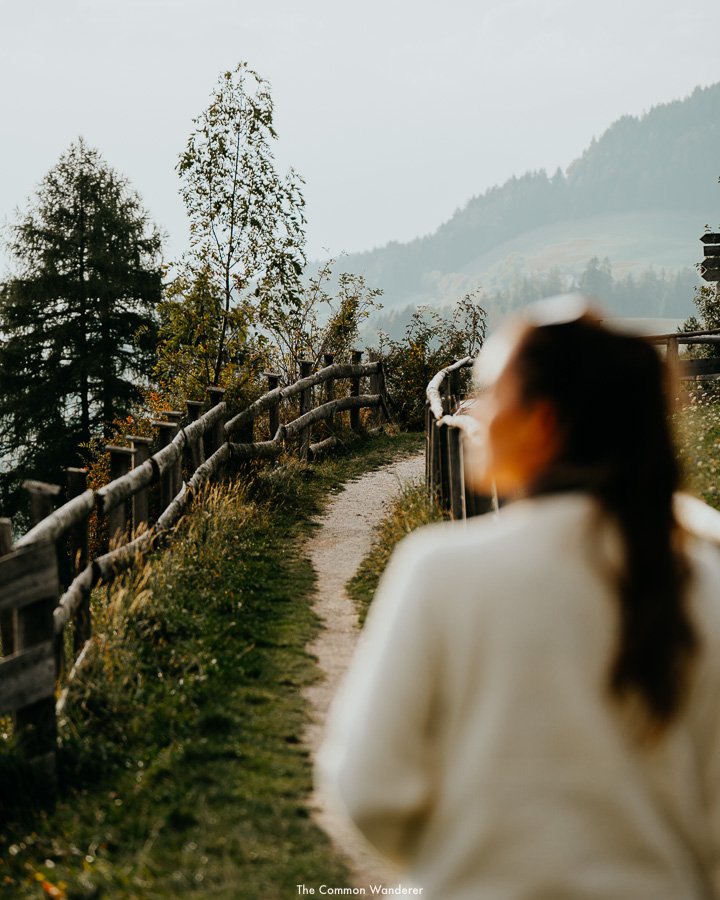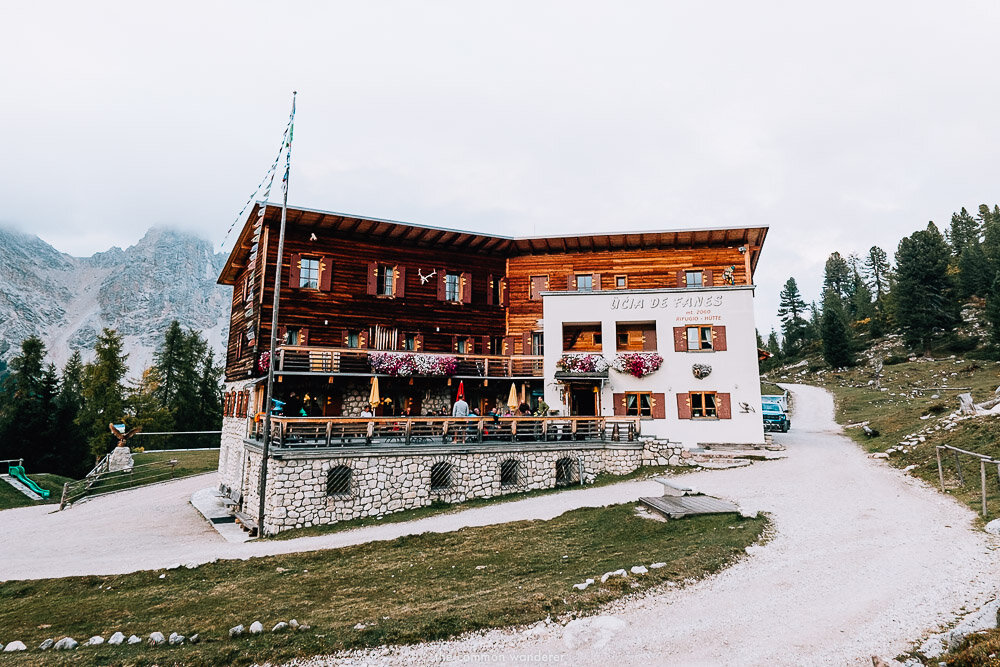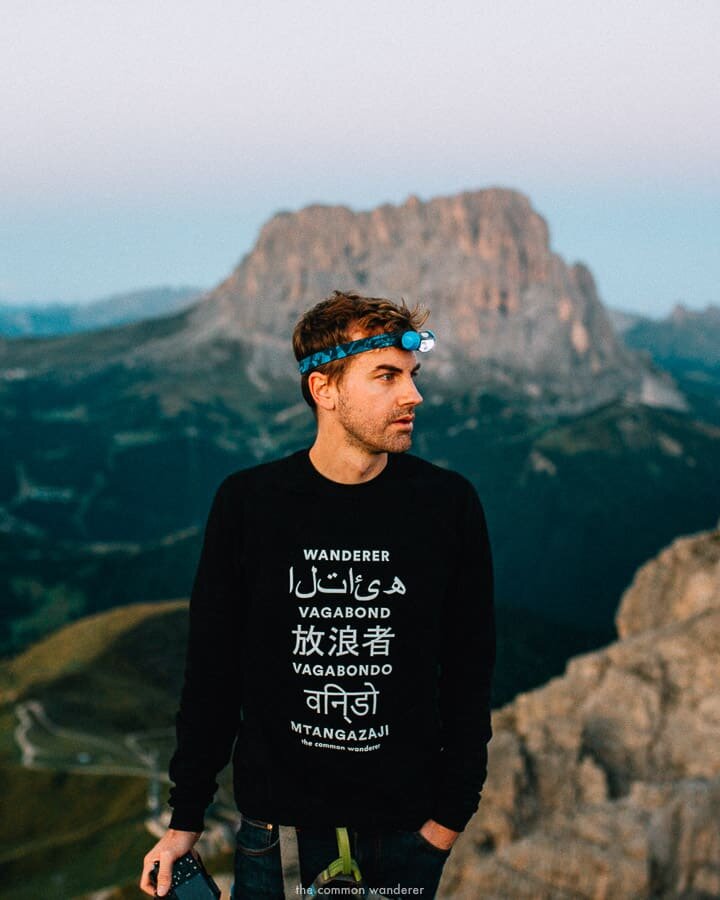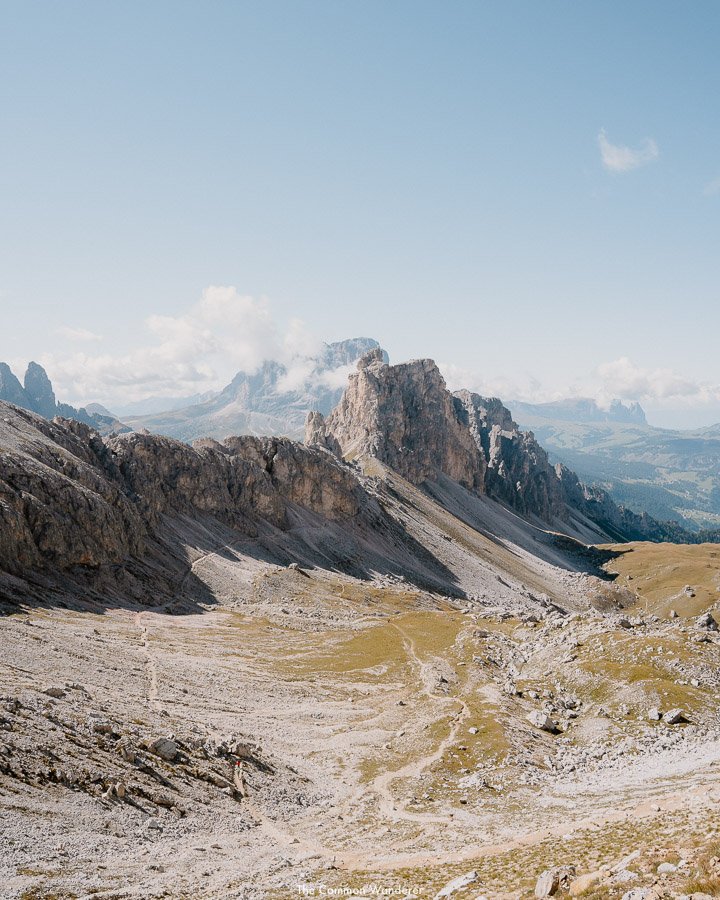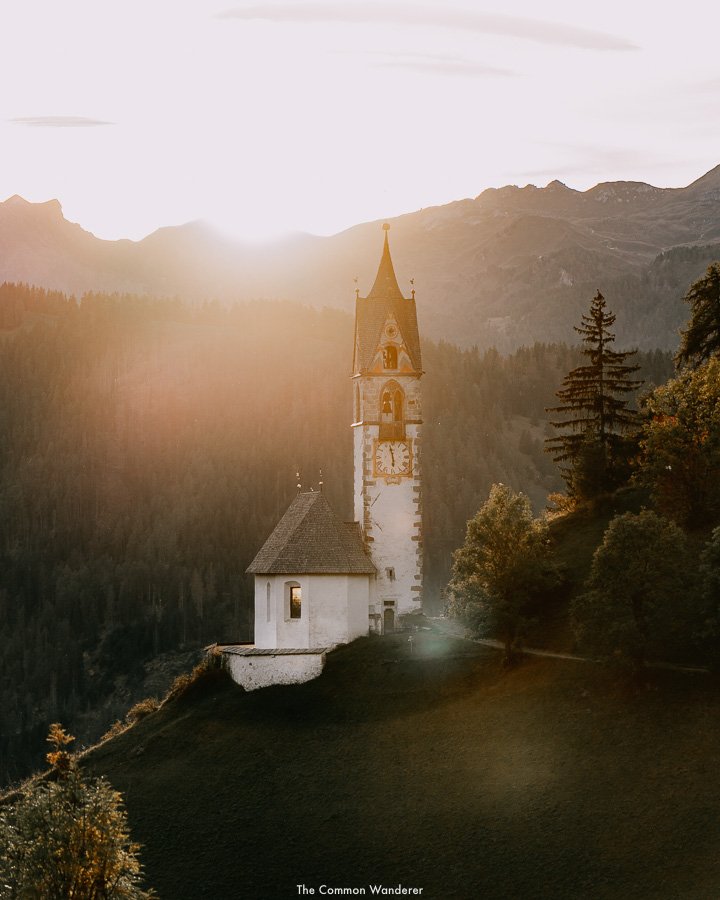An Insider’s Guide to the Most Incredible Experiences in the Dolomites
Here’s our definitive list of things to do in the Dolomites during summer.
Discover the region’s famous hikes, incredible natural attractions, beautiful towns, the best food, and where to stay.
Often when we’re bored, lying on the couch after a hard day’s work and an uninspiring episode of Ozark, we play the game, “if you could be anywhere right now, where would it be?”
In years past, we both would’ve immediately shouted Nepal, before a more considered, thought-out answer might end in Namibia, Nepal or Sri Lanka.
And then we visited the Dolomites, and it forever became the winner of our silly little game.
You see, the Dolomites, an alpine pocket in Italy’s northern reaches, are something else; a land of jagged peaks, which thrust upwards from rolling alpine meadows, endless alpine lakes, incredible hiking, quaint medieval towns, luxurious wellness areas of equally luxurious accommodation, and some of the best cuisine anywhere in the world.
They’re a place where alpine and Mediterranean traditions collide, where influences from Italy and Austria blend to create a wonderfully welcoming and enchanting destination for travellers (find out more about South Tyrol here).
We’ve now visited the Dolomites many times, and are keen to share with you our favourite things to do in the Dolomites, plus our recommendations on where to stay and eat, how to get around, and more.
Who knows, after you visit the Dolomites yourself, they might just become your answer to “if you could be anywhere right now, where would it be?”!
LOVE OUR PHOTOS? Edit like us with our European Summers Preset Packs, and mobile video filters, inspired by the warm hues and vibes of summers spent in Europe
DOLOMITES SNAPSHOT
MAIN ATTRACTIONS | Lago di Braies, Tre Cime di Lavaredo, Seceda, Alpe di Siusi, Val di Funes
BEST HIKES | Tre Cime Loop, Seceda Ridgeline, Lago di Sorapis, Vajolet Towers, Gran Cir
WHEN TO VISIT | Mid-July, Mid September - October
WHERE TO STAY | Ortisei, La Villa, Cortina d’Ampezzo, Bolzano
BEST HOTELS | Mountain Hotel Mezdi, DorfHotel Beludei or Hotel Olimpia
HOW TO GET THERE | Fly to Venice, Innsbruck, Milan or Verona. Train or bus to Bolzano
THE BEST THINGS TO DO IN THE DOLOMITES
#1 CONQUER THE BEST HIKES IN THE DOLOMITES
The Dolomites are home to some of the very best hikes in the world.
In fact, most of our visits to the region have involved multiple epic hikes; waking before dawn to chase burnt orange sunrises from mountain summits, following ancient trails that wind around the rugged Three Peaks, meandering through green woods, alpine meadows, and past turquoise creeks - and of course, enjoying break times at cute little mountain huts.
There are plenty of easy day walks (check out our guide to the best hikes in the Dolomites here) right through to full and multi-day hikes where you stop in Rifugios high in the mountains for alpine food and perhaps a cheeky schnapps, and lots of general fun with others.
A couple of our favourite hikes in the Dolomites are:
TRE CIME DI LAVAREDO LOOP (DREI ZINNEN)
These are the peaks that made the Dolomites famous; three wildly beautiful, postcard-perfect jagged monoliths as iconic to the area as the Eiffel Tower is to Paris that will undoubtedly have you awestruck as they tower above, clouds lingering at their peaks.
We’ve been to Tre Cime di Lavaredo (Drei Zinnen) three times now and would go back a million times more, we love it so!
The 10km loop from Rifugio Auronzo is a great short day hike for all levels of hiker, while history buffs can spend time exploring the WW1 tunnel systems left behind when these peaks were fiercely fought over in the Great War too.
Close by is the incredible Cadini di Misurina viewpoint, which is well worth the extra hike for one of the best views in the Dolomites.
LAGO DI SORAPIS HIKE
The Dolomites are famous for their crystal clear lakes (hello Lago di Carezza!), but the turquoise hues of Lago di Sorapis are honestly something else (read our complete guide to the hike here).
It's distinctive colour and position in the foothills of the jagged Dolomiti peaks makes it one of the most picturesque in the region, and the 2-hour hike to Lake Sorapis is one of the best things to do in the Dolomites.
Commencing from the carpark on Passo Tre Croci (in between Cortina d’Ampezzo and Misurina), the trail ascends pretty steeply through dense pine forests.
It does involve some scrambling and metal chains at some points, but the first glimpses of the milky-blue Lago di Sorapis under the imposing Mt. Sorapis are absolutely worth the somewhat challenging journey to get there.
VAJOLET TOWERS TRAIL
Rising from the rocky Catinaccio group separating South Tyrol from Trentino are the otherworldly peaks of the Vajolet Towers (Italian: Torri del Vajolet), jagged teeth-like spires that tower over the landscape below.
The Torri del Vajolet are already a popular rock climbing spot, but the trail that leads to the Vajolet Towers base makes for an incredible (if not somewhat challenging) day hike in the Dolomites.
With the typically dramatic landscapes and scenery Südtirol is well-known for, without the insane crowds you’d find at other hotspots like Tre Cime di Lavaredo, the Vajolet Towers hike is a must-see on any Dolomites itinerary.
There are multiple routes you could take to reach these peaks - we’ve covered all of them in our comprehensive guide to hiking to the Vajolet Towers.
SECEDA RIDGELINE HIKE
Seceda peak is a photographer’s dream; it's crazy dramatic and almost always moody with a sheer drop to the valley below.
We hiked up on pre-sunrise one morning when the gloomy weather had blanketed the scene with a thick fog. Right as we were about to give up hope that the sunrise would make an appearance, the clouds began to part and the peaks of Seceda and the Fermeda Towers were revealed in all their glory.
Worth it? You bloody bet!
The views from the top overlook many of the Dolomites most iconic and stunning peaks, including the Sella group, Sassolungo, and Mt. Schlern, as well as the pretty Alpe di Siusi meadow. For photography lovers and outdoor adventurers alike, a sunrise here is not to be missed.
READ | We’ve written about our favourite short hikes in the Dolomites; read about them here
#2 ADMIRE THE BEST LAKES IN THE DOLOMITES
The mountains might be the Dolomites’ most famous and obvious feature, but no alpine region is complete with glacial lakes, and there are so many incredible ones in the Dolomites.
Below are some of our absolute favourites, one of which you guys probably know already (it’s kinda famous!):
THE STUNNING LAGO DI BRAIES (PRAGSER WILDSEE)
The most iconic alpine lake in the Dolomites, Lago di Braies (Pragser Wildsee) is famous the world over for its emerald waters, ubiquitous boathouse, beautiful spruce pines forests and towering limestone peaks.
Unsurprisingly, it’s more impressive in 3D, and worthy of a sunrise visit to avoid the crowds and savour the beauty (save for the 100’s of photographers that scramble for the best vantage points, even in the early hours - it’s not known as Lago di Instagram for nothing!). On that, if you do decide to visit, please don’t be one of those people who break into the boatshed (there’s actually a €150 fee to shoot here) or the tied-up boats for their shot.
If the crowds get a bit too much, take the picturesque 1-hour walk which follows the shores of the lake and provides picturesque views from almost every angle.
THE DETAILS
WHERE | Lago di Braies / Pragser Wildsee
COST | 30min boat hire: €18, €150 photography fee for the boathouse
READ | Our complete Lago di Braies guide
THE RAINBOW LAKE OF LAGO DI CAREZZA(KARERSEE)
Perhaps our favourite lake in the Dolomites, Lago di Carezza (also known as Karersee in German), and its picture-perfect reflections of the Latemar range, have long made it a popular choice with tourists and photographers alike - and we have to admit that despite its buzz as an ‘insta-worthy’ destination, it really is one of our favourite places in the whole of South Tyrol and the Dolomites.
Probably more so than Lago di Braies.
The stunning emerald waters of Lago di Carezza are just a short drive from Nova Levante, and are best witnessed in the early morning just prior to sunrise. Watch the sun hit the top of the jagged limestone peaks of the Latemar range, before encasing the valley in a golden glow.
Once you’ve witnessed nature doing her thing, take the short 20 min walk around the lake, enjoying the fresh mountain air and misty spruce forests.
THE DETAILS
COST | Parking is free for the first 15 min, then €1 per hour for each hour after that
STAY | Hotel Stella Stern in Nova Levante
Other amazing lakes in the area we recommend looking out for are Lago di Sorapis (read our guide here), Lago di Dobbaico, Misurina, Lago d’Antorno, Lago di Landro, Lago Federa (near Croda da Lago) and the pretty little lake of Lago di Fie.
#3 WANDER THE ALPINE MEADOW OF ALPE DI SIUSI
Alpe di Siusi is one of those ’too beautiful to be real’ type places, so it’s understandably become an Instagram playground over the last few years. Despite this, it's honestly beautiful and your jaw will be pinned to the green pastures around you as you admire the views here.
The largest alpine meadow in Europe is home to iconic views of rolling hills and alpine huts of the Dolomites and is best enjoyed for sunrise before the crowds arrive.
We suggest hiking into the meadow and cabins before watching the sunrise behind the mountain peaks in the distance.
Our friend and South Tyrolean local @guiligartner suggests hiking to Adler Lodge Alpe or Malga Sanon for the best photography location.
You’re not actually allowed to drive into Seiser Alm (read more here) unless you’re staying in the area or have a local permit (and it’s a whopping €150+ fine if you do!), so we suggest parking at Compatsch and walking into the meadow at your own pace.
THE DETAILS
Where | Alpe di Siusi, Selva di Val Gardena
Stay | If you want to stay in the meadow, we recommend Adler Lodge Alpe
Tips | Don’t get fined €150 for driving in - hike into the area instead!
Read | Our guide to Alpe di Siusi
#4 TAKE A DOLOMITES ROAD TRIP
From Australia to Namibia, the Faroe Islands to Slovenia, we’ve taken many road trips around the world, and it’s safe to say a roadie through the Dolomites is right up there as our favourite.
The Dolomites are one place you really want to be a passenger (lucky for Mim she doesn’t drive!), and be mesmerised by the jagged peaks, emerald lakes, verdant meadows, and quaint little towns.
In fact, if you’re the passenger in these mountains, it’s your duty to shout “pull over” when yet another outrageous view appears. And there are many; we’ve lost count of the number of times we’ve stopped and pulled over, jaw firmly on the floor, and drooled over the views in front of us.
Although public transport in the region is exceptional (seriously!), the only way you can really enjoy each and every corner of the Dolomites, with flexibility for spontaneity, is via having your own car.
Fortunately, car rental prices are affordable, the roads are exceptional, and the drivers are slightly less… shall we say ‘Italian’, in these parts.
After extensively travelling through the Dolomites, we’ve put together a comprehensive Dolomites road trip itinerary for you guys to follow, which you can read here.
Our itinerary covers everything from the insta-perfect lakes to the vertiginous rocky peaks, incredible day-hikes to the must-see museums, not forgetting a host of incredible restaurants, and a spot of adrenalin here and there. It’s an easily followed circular loop through some of the region’s most beautiful roads and stunning regional towns, starting and ending in the accessible and wonderfully pretty city of Bolzano.
Use our Dolomites road trip guide as your bible, and you’re sure to have the best week of your life.
#5 DRIVE OVER THE DOLOMITES’ FAMOUS MOUNTAIN PASSES
If you’re planning a road trip through the Dolomites (read above!), then you’ll surely want to tackle some of the incredible mountain passes scattered throughout the region.
As road trip lovers and mountain fanatics, a high alpine pass gets us giddy with excitement every single time.
There’s nothing better than slowly winding your way along an edge-of-your-seat mountain roads and hairpins, encased by large trees and ever-larger mountains, overlooking the slowly shrinking valleys below, with your favourite road trip tunes pumping.
And in the Dolomites, there are many incredible mountain passes. Fortunately, the roads are well maintained, so, while the passes can be adrenalin inducing and a little scary at times, you’ll be safe and sound.
Driving over a Dolomiti mountain pass is one of the best things to do in the Dolomites, so here are some of our favourites:
PASSO GARDENA
Of all the Dolomites mountain passes, Passo Gardena is by far the most popular. Connecting the Val Badia and Val Gardena valleys, the pass is not only incredible (especially at sunrise or sunset), but is also a great starting point for a number of incredible hikes and via ferrata, including the wonderful Gran Cir peak.
During autumn, the surrounding larches turn a wonderful shade of yellow/orange, making a drive-through here even more delicious.
PASSO GIAU
Nestled between the Croda da Lago and Cinque Torri, Passo Giau connects Cortina d’Ampezzo with Selva di Cadore, and is perhaps the most beautiful mountain pass in the Dolomites.
The 2,236m pass winds through dense larch forests and a high alpine plateau, with spectacular views amongst the surrounding peaks, making it outrageously picturesque. You must stop at the top and take a short walk into the pastures, or alternatively, start a longer hike into the mountains.
SELLA PASS
The Sella pass winds between the peaks of Sassolungo and the Sella Towers, and is just as beautiful as the others, with slightly less crowds.
Best visited during the sunset hours, when the mountains turn that uniquely Dolomites shade of red/orange, before the skies turn purple.
Sella Pass is actually just down the road from Passo Gardena, so if you’re looking for a hairpin kinda day, combine both.
#6 DEVOUR THE DELICIOUS ALPINE CUISINE
If Italy is one of the world’s culinary royals, then South Tyrol has to be the shining star in its crown (our humble opinion, but we’ll own it!).
Not only is it the country’s most decorated culinary province (it has 26 Michelin stars shared by 19 restaurants), South Tyrol’s cuisine melds together the very best of Italian food and the hearty alpine influences of Austria and Germany with centuries-old food traditions to create totally unique, mouth-wateringly delicious dishes that soothe the soul.
Basically, it’s heavenly alpine cuisine that makes you feel warm and fuzzy inside.
We’re talking fresh pasta, cheese straight from the region, the freshest of ingredients, and generous mountain meals that comfort and soothe aching muscles at the end of a long day outside - all accompanied by brilliant local wine, of course!
In the Dolomites, there’s a seasonal, farm-to-table approach to food, with a focus on sustainable food sourcing and practice at the heart of almost every meal. Here, produce is often foraged in the woods nearby or sourced from small-scale farms, and you truly get the sense that every dish you eat has been produced in harmony with the surrounding valleys and peaks.
What’s more, there are plenty of options for vegetarians (like us), the food here is generally really affordable, and no matter where you eat, it’s consistently good, every. single. time.
When you visit, we totally recommend you try these dishes:
Cheese dumplings | Bread dumplings mixed with local cheese. They’re delicious, and hearty as hell
Schlutzkrapfen | Far more delicious that it’s name sounds, it’s ravioli type dumpling with spinach, ricotta and chives
Kaiserschmarrn | A fluffy shredded pancake served with applesauce and cream. Dessert heaven
And these are a few essential places to eat in the Dolomites:
Alpinn | Serves locally sourced produce with some of the best views from Kronplatz. Alpinn has a local mountain to plate philosophy, and their signature risotto with wild garlic and wood sorrel is to die for. Be sure to have a Mountain Spritz, made only with local ingredients!
Oberholz | Located in a architecturally designed mountain hut, Oberholz has a ridiculously good risotto with mushrooms and flowers straight from the mountain
Rifugio Ütia Bioch | Rifugio Utia Bioch, located on Piz Sorega, serves fresh South Tyrollean food overlooking Marmalada
#7 EXPLORE THE IDYLLIC VAL DI FUNES
Val di Funes - a little pocket of heaven in northern Italy that needs to be seen to be believed. Nowhere else we’ve been before has measured up to the serenity and beauty on offer in this valley.
Everywhere you look is fairytale-esque, from its two biggest drawcards, the onion-domed churches of St Maddalena and St Johann in Ranui, to the towering peaks of the famed Puez-Odle National Park, Val di Funes is serene, seemingly untouched by the advances of the modern world. Furthermore, the hikes are wonderful, the food exquisite, and the villages charming.
Located close to all the major Dolomites entry points, Val di Funes has become increasingly popular amongst visitors to the Dolomites due to Instagram fame, yet has somehow managed to remain peaceful, quiet, and removed from the hubris.
That doesn’t mean there’s nothing to do - there’s plenty to keep you busy, but a visit here is more about taking it slow and healing the head and heart.
So come here to take that Instagram photo, stay to hike, bike or simply stare in awe of these mountains. You won’t be disappointed.
READ MORE | Our complete guide to Val di Funes, including what to see and do + where to stay
#8 SPEND THE NIGHT (OR MANY) IN A RIFUGIO
Years ago, we stumbled across a photo of the infamous Rifugio Locatelli near Tre Cime di Lavaredo while scrolling Instagram and distinctly remember thinking “we have to stay here”.
And it was in that pretty little mountain hut where we spent our first ever night in the Dolomites. It was amazing. We ate hearty alpine food amongst a crowded dining hall, where laughter abound. We slept soundly, window open enjoying the fresh mountain air. And we rose early, just before sunrise, to experience Drei Zinnen at their most majestic.
Having enjoyed many a day and night in the teahouses of Nepal, we felt right at home (albeit with a few more home comforts than Nepali teahouses!), enjoying the wonderful confines of these traditional huts.
Ubiquitous here in the mountains of the Dolomites, rifugios/alpine huts are a great place to embrace the alpine culture that exists within the region, where you can enjoy hearty food, beer/schnapps, a convivial atmosphere and a decent night’s sleep after a hard days walking.
Or, if you arrive early enough, join your fellow hikers on the terrace with a beer and some sun therapy.
The majority of rifugios in the Dolomites are privately owned, and need to be booked well in advance online (old school, no booking.com here!). They’re sometimes dirty, sometimes basic, and sometimes rowdy, but always wonderful.
Some of our favourite and most picturesque rifiugios are:
Rifugio Locatelli | Located in the heart of Tre Cime di Lavaredo, it’s easy to visit and wonderfully authentic
Fanes Hütte | Nestled in the Fanes National Park, this pretty hut has very nice rooms and a wonderfully convivial atmosphere
Rifugio Vajolet | Located below the Vajolet Towers, this is one of the more picturesque rifugio in the Dolomites. Definitely worth a stay
Rifugio Nuvolau | We’ve not stayed here, but this rifugio, perched on a cliff edge, is probably the most impressive and photogenic in the area. Founded in 1883, by the way!
#9 TRY A VIA FERRATA IN THE DOLOMITES
Hiking is great and all, but you’ve not really experienced the Dolomites unless you’ve done a via ferrata.
What’s a via ferrata (roughly translated to iron path in Italian), we hear you ask? It’s basically a protected climbing route, which uses steel cables, rungs, or ladders, fixed to the rock to allow climbers to safely ascend and descend with a harness if needed. It’s similar to rock climbing, but hikers can complete one without the technical knowledge and know-how.
They rose to prominence during the First World War when this region was hotly contested and soldiers needed a way to move quickly and securely through the mountains. Now, they exist for our adrenaline-fuelled adventures!
On one glorious autumn morning, we got to experience a via ferrata to the summit of Gran Cir in Alta Badia for sunrise. Sure, it was an easy introduction to a via ferrata, but the experience was no less exhilarating.
Starting from Passo Gardena (Rifugio Frara), we made our way up a steep scree gully towards the summit. It was pitch dark, save for the headlamps which shone brightly amongst our fellow climbers. From there, it was a slow and steady mix of hiking, scrambling and rock climbing, punctuated by breaks in which to catch our breath on this steep ascent in horribly humid weather. Despite the early wake-up, the rush of adrenaline as we reached the summit was immeasurable.
From the peak, the sunrise was truly spectacular - a 30-minute long show featuring mother natures most brilliant set of colours - from blue to purple, red to orange, culminating in the sun peaking over Cima Cunturines in the distance. From the peak, it’s possible to enjoy the 360-degree views of the Dolomites surrounding you, including the Sella Group, Sassolungo, and the Monte Antelao and Pelmo.
On the way down, we stopped in at JimmiHütte for a delicious South Tyrolean breakfast.
There are many via ferrata available throughout the Dolomites region, including around Tre Cime, which you can read about here.
THE DETAILS
WHERE | Rifugio Frara, start of Gran Cir hike
TIPS | Wear sturdy hiking boots, and bring a head lamp if summiting for sunrise
READ MORE | What to see and do in Alta Badia
#10 EXPLORE THE PRETTY LITTLE TOWNS AND HAMLETS
It’s obvious that the Dolomites are alllll about the natural environment, but one thing that really struck us when we first visited is how beautiful the towns and hamlets dotted throughout the region were.
They’re like a treasure trove of fairytale villages, with cobblestone streets, ancient churches covered with frescoes, pastel-coloured laneways, enchanting gardens and fountains, chalets and homes covered in flower boxes, all surrounded by the imposing Dolomiti peaks.
Honestly, it’s overwhelmingly beautiful at times.
Bolzano (Bozen), Merano (Meran), and Trento are three of the largest towns/cities in the region are exceedingly beautiful, its ancient old town, Mediterranean-style villas, pastel facades, turquoise alpine rivers and tree-lined streets.
San Candido (Innichen), located in the pretty Pusteria Valley in the Sexten Dolomites near Drei Zinnen, is potentially our favourite mountain village. It may be small, but it makes up for it in pastel-coloured laneways and quiet, cobbled streets, which lead the medieval town centre. Surrounded by the Drei Zinnen Nature Park, this lush green valley is a must-visit.
Close by is Cortina d’Ampezzo, made famous by James Bond’s ‘For Your Eyes Only’ (which incidentally is Mark’s favourite Bond!), and the 1956 Winter Olympics. It’s basically the Positano of the Dolomites, with the wealth and status to match.
Ortisei/St. Ulrich, Seis/Siusi, and San Cassiano/St. Kassian, all located in the heart of the Dolomites, and are starting points for hiking and skiing adventures, yet also are exceedingly beautiful.
But whichever town you pull up in, you’ll no doubt do as we do - walk around with your jaw to the floor, in awe of what you’re seeing.
#11 SPEND TIME IN STUNNING ALTA BADIA
Located right in the heart of the imposing Dolomites, and inhabited by the Ladin peoples, with their own language and mountain culture, things are different when compared to other parts of the Dolomites.
There’s a deep, mythological appreciation of the mountains and meadows, and you feel it when you visit - the unfamiliar greetings (hello = Bun dé, thank you = Giulan), the myths told on hikes and the appreciation of sunrise from a mountain peak.
It makes Alta Badia a wonderful and unique place to visit, especially in summer when the hills come alive.
In terms of hiking, Alta Badia is stacked, with some of the best trails in all of the region.
We suggest at the very least, attempting the Crespeina lake - Forcella Ciampëi, Gardenacia to Rifugio Puez, and Armentara Meadows hikes, which you can read more about here.
We highly recommend spending one afternoon watching the sunset in the hills of La Val, overlooking St. Barbara Church, one of the most beautiful, serene views in all of the Dolomites.
Set on a panoramic hill with the peaks of the Puez-Odle national park searing behind, it makes one of the most beautiful backdrops in all of the Dolomites.
Oh, and if you like food and wine (who doesn’t), stop by the Michelin-starred St. Hubertus, try local wine at La Cianoa, and sample local cuisine at Rifugio Utia Bioch.
PLAN | Use our detailed Alta Badia guide to plan your trip
#12 EMBRACE THE HEALTH AND WELLNESS
Hot. Cold. Water. Air. At one with nature. Liberating. Centring.
Life in the Dolomites is very much a celebration of all the best things in life; an appreciation for natural beauty, total wellness of your mind, body, and soul, and embracing a slower, more meaningful existence.
We adore mountain culture in the Dolomites, and a huge part of that culture is the commitment to wellness; spas, saunas, massages, yoga, you name it - embracing the wellness culture in the mountains is one of the best things to do in the Dolomites.
But what is wellness exactly, and why is it so amazing?
Wellness is the act of practising healthy habits to better attain physical and mental health - and it’s noticeable here in the Dolomites. Nearly everyone you see is focused on living their best life, be it hiking, biking or even paragliding. Once the day’s activity is done, though, there’s a collective enjoyment of wellness - spas, saunas, stretching, massages, before an aperitif, then a slow and considered meal using incredible fresh produce.
Almost every hotel in the Dolomites is designed with health and wellbeing in mind, and we love it.
So where is the best place to enjoy wellness in the Dolomites? Basically anywhere that you want it to be. For us, it’s walking through the dense forests below Seceda, before watching a golden sunset over the mountains. Or watch the sunrise from Gran Cir with coffee and chocolate in hand. Or enjoying a spa or sauna with an Aperol Spritz after a long days hike.
We’ve experienced the very essence of wellness at the Hotel Miramonti, located in the mountains above Merano. Overlooking the city from 1200m above sea level, the hotel has the most incredible infinity pool that floats effortlessly above the valley. There's also an assortment of onsen pools, relaxation rooms, and spa treatments dotted throughout the mountainside and forests that provide space for thought and relaxation. It’s heaven, trust us.
Another incredible hotel with wellness at the centre of their ethos is Hubertus Alpin Panorama Hotel in Kronplatz.
Its world famous cantilevered skypool overlooking the Dolomites is basically the greatest thing we’ve ever seen, as well as its Alpenreych Spa, which has 6 indoor and outdoor pools, sauna and steam bath, and the Blockhouse sauna with panoramic view to the mountains.
#13 GO PARAGLIDING ABOVE THE DOLOMITES
Of all the experiences we’ve had in the Dolomites, paragliding over the unique landscapes and quaint towns of the region stands out.
It wasn’t always this way.
Leading up to the flight, one half of TCW was quietly shaking with fear, convinced her life was about to end in the skies above the Dolomites.
As it turns out, she needn’t have worried; paragliding is actually incredible calm and relaxing, and oh so exciting. And doing so above a UNESCO World Heritage-listed marvel such as the Dolomites is quite the experience.
Setting off from the windy, clouded peak of Monte Elmo, we floated high above the Puster Valley, admiring the jagged peaks of the Dolomites on one side, and the snowy mountains of Austria on the other.
Towards the end of our flight, our guides, Michael and Leo, sent us into an adrenaline-inducing tailspin before landing comfortably in the green fields of Sesto - an experience we’ll both never forget, and definitely one of the best things to do in the Dolomites.
THE DETAILS
WHERE | Monte Elmo (Helm), Sexten
COST | €160 per person
BOOK | Book directly through the Cumulus Club Sexten by calling local pilot Michael Rogger at +39 348 7047158, or email at info@appartements-michael.com
TIPS | It can be cold up in the sky, so wear layers
#14 LEARN ABOUT THE MOUNTAIN CULTURE
The Dolomites, and the regions they fall within, have a long a storied history, and is often overlooking by visitors to the region. So for culture vultures looking for something beyond the epic scenery and incredible hiking, there’s much to see and do.
Bolzano and Merano are home to an array of wonderful museums, including the South Tyrol Museum of Archaeology, which is home to Ötzi the Iceman, Europe’s oldest natural human mummy, who was found in 1991 buried in a glacier in the Öztal Alps, in South Tyrol.
In the mountains of the Dolomites, centuries-old traditions, striking castles, quaint towns, and generous hospitality beckons, and from one village to the next, you’ll encounter different languages, dialects (including the super unique ancient Ladin language, which is spoken in just the Val Badia and Val Gardena valley – by roughly 4 % of the inhabitants!), and traditions.
If you’re keen to learn more about the Ladin culture, make a visit to the Ladin Museum at Tor Castle, which has exhibitions on the geology, archaeology, history, language and handicrafts of the five Ladin speaking valleys.
The centre point of all things mountain culture is the imperious resort of Kronplatz, which houses the must-visit Messner Mountain Museum Corones, and the Lumen Museum of Mountain Photography.
Designed by famed architect Zaha Hadid, Messner Mountain Museum Corones is curated by famous mountaineer, Reinhold Messner and is dedicated to traditional mountaineering and mountain history of the Dolomites and Alps.
Surrounded by incredible views of the Dolomites and with a cantilevered viewing platform showcasing the best views, the museum is well worth an hour of exploring.
A short walk away is the Lumen Museum of Mountain Photography, a one-of-a-kind space dedicated to mountain photography and potentially our favourite museum ever (Mark just loves photography and mountains!).
Built into the old cableway station, this architecturally designed building takes you through the history of mountain photography, as well as adding modern-day elements (the mirror room is the best room in the building!) across four floors.
#15 INSTA-WORTHY PLACES IN THE DOLOMITES
Okay guys, you might be shocked to notice that we’ve not included a few insta-famous places on our list of what to see and do in the Dolomites, but with good reason (at least we think); they’re mostly just pretty photo spots without much more going for them.
That being said, it would be remiss of us to not include these places on our post, so here are a few additional places to visit if you want those insta-bangers!
St Johann in Ranui church | This delightful little church sits in a meadow at the base of the magnificent Geisler mountains forming the perfect frame for your images. Access is restricted in the valley, with an access path leading to the church, however, there’s an area just a bit further back to nail the famous photo. Best at sunset
Val Di Funes | As if lifted from a movie set, the famous town and setting of Val di Funes is a gorgeous stop. If you’ve got time, explore more of the valley and wander the hills above the town
That famous lookout near Tre Cime di Lavaredo (Cadini di Misurina) | Near rifugio Auronzo at the carpark of Tre Cime di Lavaredo, if you look towards lake Misurina you will see an incredible set of jagged mountain peaks - Cadini di Misurina. They’re super insta-famous now, but absolutely breathtaking. Basically, walk away from the car park and follow the ridgeline towards the mountains for that epic viewpoint (see below). It takes about 30-40 mins, but you can’t miss it.
DOLOMITES FAQS & TRAVEL INFORMATION
WHERE ARE THE DOLOMITES?
The UNESCO World Heritage-listed Dolomites are located right in the north of Italy and span the regions of South Tyrol/Alto Adige-Trentino, Veneto and Venezia.
They’re wedged between the mountains of Austria and the plains of Italy which lead to the Mediterranean, which means contrasting landscapes and climatic conditions - picture Mediterranean-style vineyards overlooking the imposing mountain peaks.
The area has long been disputed amongst European powers - indeed it fell under Austrian rule for centuries before changing hands during WW1, when it was annexed by Italy; the current autonomous region is home to three official languages, German, Italian, and Ladin, the local indigenous language.
The area feels more Austrian than Italian, but in our opinion, it's the best of two pretty amazing cultures.
The capital of the area is the beautiful city of Bolzano (Bozen), however, the main cities and towns include Trento, Bressanone (Brixen), Cortina d'Ampezzo and Brunico (Bruneck).
WHERE TO STAY IN THE DOLOMITES
Looking for where to stay in the Dolomites? We’ve written a huge guide on where to stay in the Dolomites (it’s seriously huge!). From luxury hotels to airbnbs, our guide has your Dolomites accommodation well and truly sorted.
The region of South Tyrol is littered with a great range of accommodation options, including hotels, guesthouses, Airbnbs and alpine huts. Accommodation in the region can be quite expensive, so we recommend budgeting for a minimum of €100 per night, however options for all budgets exist in abundance.
READ MORE | Our complete Dolomites accommodation guide
TRAVEL INSURANCE | STAY SAFE IN THE DOLOMITES
If you can't afford travel insurance, you really can't afford to travel. As COVID-19 taught many people, things can go wrong anywhere in the world - and insurance is often the only way of mitigating any issues with minimal expense or stress for you.
Here are our recommendations, based on 8+ years of full-time travel:
FOR TRAVELLERS | HeyMondo - Comprehensive travel + medical insurance, an app with 24-hour medical support, and no out-of-pocket fees. *Get 5% off your policy by booking through our link here.
FOR DIGITAL NOMADS | SafetyWing - Comprehensive travel & medical, and policies can be purchased while already abroad.
CAR INSURANCE | Insurance4CarHire - a great annual car insurance policy
PLANNING A TRIP TO THE DOLOMITES SOON?
Check out these essential posts to help you have the best trip ever:
DOLOMITES | Our Dolomites Travel Guide, Top things to do in the Dolomites, Our 7-day road trip itinerary for the Dolomites, Where to stay in the Dolomites, How to get to the Dolomites
DOLOMITES DESTINATION GUIDES | Summer in Alta Badia, A guide to Val di Funes, A complete guide to Alpe di Siusi, How to visit Lago di Carezza, our guide to Lago di Braies,
HIKES TO REMEMBER | 7 of the best day hikes in the Dolomites, including the famous Tre Cime De Lavaredo loop, Violet Towers hiking guide, Hiking to Lago di Sorapis, Cadini di Misurina
SOUTH TYROL | 19 amazing things to do in South Tyrol during Summer, plus everything we love about the beautiful South Tyrol region
PHOTOGRAPHY | Love our photography? Grab the presets we use on every photo here
RESPONSIBLE TRAVEL | Responsible travel is important. REALLY IMPORTANT. Learn our top responsible travel tips to help you, your family and friends travel more consciously around the globe
PLAN YOUR ULTIMATE DOLOMITES TRIP
Some of the links on this guide to the best things to do in the Dolomites are affiliate links.
If you choose to purchase using these links, we receive a small commission at no extra cost to you. Please know that by using these affiliate links, you're directly supporting The Common Wanderer to stay wandering, the running costs of the site, and our ability to provide you with free content to help you on your travels.
That, and you're officially a legend.

